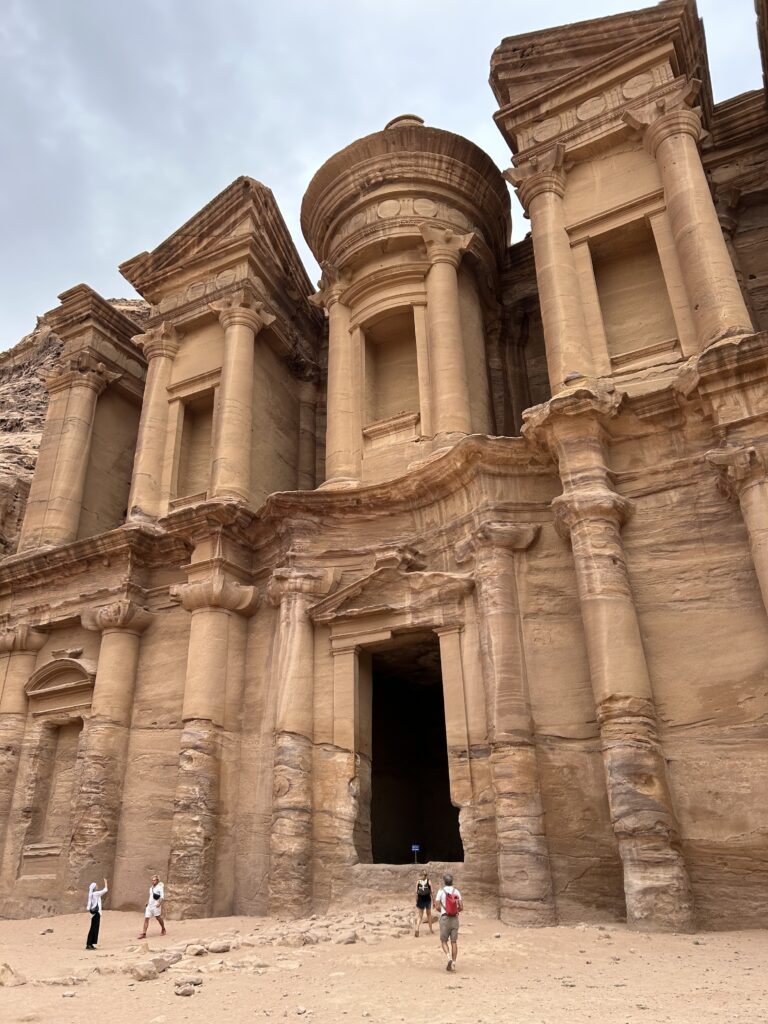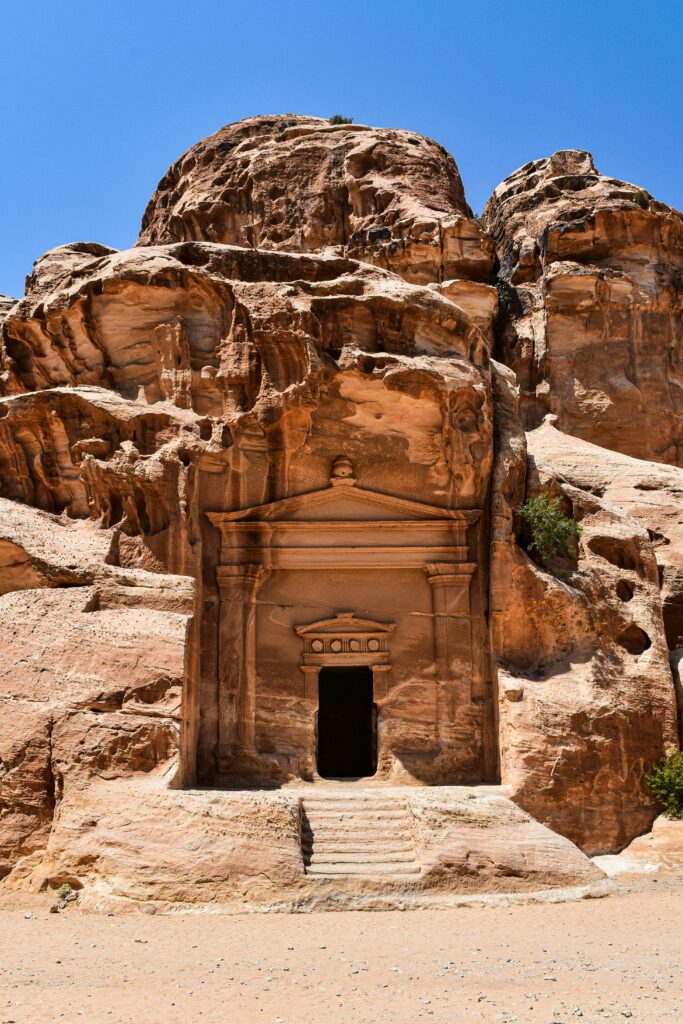The lost city of Petra, a UNESCO World Heritage Site and one of the New Seven Wonders of the World, is one of the world’s most awe-inspiring archaeological wonders, hidden deep within the rugged desert canyons of Jordan. This ancient city, built by the Nabataeans more than 2,000 years ago, showcases breathtaking rock-cut architecture, an advanced water management system, and a rich history that still captivates travelers and historians today. From the iconic Treasury to the hidden marvels of Little Petra and The Monastery, exploring Petra feels like stepping back in time. Petra is a must-visit destination for those seeking history, adventure, and stunning landscapes. This guide takes you through everything you need to know about Petra—its location, history, famous landmarks, and how to experience its magic firsthand.
- Where is Petra located?
- When was Petra built and who built it?
- The Treasury, Petra: A magnificent icon
- Petra inside: What lies beyond The Treasury?
- Exploring the Petra tombs
- The Monastery, Petra: A hidden marvel
- Little Petra: A glimpse into Nabataean life
- Why was Petra abandoned?
- Final thoughts on the lost City of Petra: A must-visit destination
- Extra: Quick Petra one-day itinerary
Where is Petra located?
Nestled in the heart of Jordan, Petra is an archaeological marvel and one of the world’s most breathtaking historical sites. This ancient city lies between the Red Sea and the Dead Sea, hidden within the rugged desert canyons. The closest city is Wadi Musa, which serves as the gateway for travelers looking to explore Petra.

The site is easily accessible from Jordan’s capital, Amman, making it a popular destination for history lovers and adventurers alike. The journey from Amman to Petra takes around three hours by car, with buses and private tours offering convenient transportation options. Some travelers even opt for hiking routes through the surrounding desert, immersing themselves in the breathtaking scenery before reaching the city.
When was Petra built and who built it?
Petra’s origins trace back to the 4th century BC, built by the Nabataeans, a powerful Arab trading civilization. Skilled engineers and architects, the Nabataeans carved their city into the pink sandstone cliffs, creating one of the most stunning rock-cut architectural wonders in history. Petra flourished as a major trade hub, connecting Arabia, Egypt, and the Mediterranean. Its advanced water management system allowed it to thrive in the harsh desert climate, with intricate aqueducts and reservoirs supplying the city with fresh water. However, Petra’s prosperity began to decline after trade routes shifted, and a devastating earthquake in the 4th century AD further damaged its infrastructure. By the 7th century, it had been largely abandoned, left to the sands of time until its rediscovery in 1812 by Swiss explorer Johann Ludwig Burckhardt.
The Treasury, Petra: A magnificent icon
The Treasury, known as “Al-Khazneh,” is Petra’s most famous and recognizable landmark. Standing nearly 40 meters high, its intricately carved façade is a masterpiece of Nabataean architecture, blending Greek and Middle Eastern influences. Historians believe The Treasury was originally a royal tomb, later used as a temple. Carved directly into the sandstone cliffs, its impressive Corinthian columns, friezes, and statues make it an unforgettable sight.

While visitors can marvel at its exterior, entrance to The Petra Treasury inside is restricted to preserve its delicate structure. The interior consists of a relatively simple chamber, leading to speculation about its original purpose. Some theories suggest it may have served as a treasure vault, although no significant artifacts have been found inside.

Petra inside: What lies beyond The Treasury?
While The Treasury is the most famous attraction, it is only the beginning of Petra’s wonders. Beyond this stunning façade, the ancient city extends deep into the rocky landscape, revealing tombs, temples, and an impressive Roman-style theater. The Siq, a narrow 1.2-kilometer-long gorge, serves as the dramatic entrance to Petra, leading visitors to its many hidden treasures. As travelers explore Petra, they will encounter various rock-carved dwellings, staircases, and sacred altars, each revealing the sophisticated urban planning of the Nabataeans. The city of Petra covers approximately 264 square kilometers, making it one of the largest archaeological sites in the world. Many chambers remain undiscovered, adding to Petra’s aura of mystery and intrigue.

Exploring the Petra tombs
Petra is home to an extensive necropolis, with thousands of rock-cut tombs scattered throughout the site. Among the most famous are the Royal Tombs, a series of elaborately carved burial sites that include the Urn Tomb, the Silk Tomb, the Corinthian Tomb, and the Palace Tomb. These structures highlight the Nabataeans’ architectural ingenuity and showcase a blend of Egyptian, Greek, and Roman influences.

The intricate designs and sheer scale of these tombs reflect the wealth and power of Petra’s elite. Some of these tombs still contain traces of their original painted decorations, offering a glimpse into the artistic sophistication of the Nabataeans.
The Monastery, Petra: A hidden marvel
The Monastery, or “Ad Deir“, is one of Petra’s largest and most awe-inspiring structures. Reaching it requires a strenuous 800-step climb, but those who make the journey are rewarded with breathtaking views of the surrounding mountains and valleys. Measuring nearly 50 meters wide and 45 meters tall, The Monastery is larger than The Treasury, though its design shares similar architectural elements.

The Petra Monastery inside features a vast hall with a central altar, believed to have been used for religious ceremonies. The effort to reach The Monastery is well worth it, as the panoramic views from the nearby viewpoints provide the most spectacular sights in Petra.

Little Petra: A glimpse into Nabataean life
Located a few kilometers from the main site, Little Petra, or “Siq al-Barid“, offers a quieter yet equally fascinating experience. This smaller settlement was likely a suburb or a resting place for traders traveling along the incense route. Featuring rock-cut homes, water channels, and stairways leading to lookout points, Little Petra provides valuable insights into everyday Nabataean life.

Unlike the main city, it sees fewer visitors, making it a perfect spot for those seeking to explore Petra’s history without the large crowds. The frescoes found inside one of its rock-cut houses are among the best-preserved Nabataean paintings, depicting scenes of vines and mythological figures.
Why was Petra abandoned?
Despite its ingenuity and prosperity, Petra’s decline was inevitable. A devastating earthquake in the 4th century AD caused widespread destruction, crippling its water management system and infrastructure. Additionally, the shift in major trade routes reduced its economic importance. By the 7th century, the once-thriving metropolis had been largely abandoned, left vulnerable to the elements. Over time, sandstorms and erosion buried much of the city, preserving it in near-perfect condition until its rediscovery in the 19th century. Today, Petra stands as a testament to the ingenuity and resilience of the Nabataeans, attracting millions of visitors eager to uncover its secrets.
Final thoughts on the lost City of Petra: A must-visit destination
Petra, Jordan’s lost city, remains one of the world’s most captivating archaeological wonders. Whether marveling at The Treasury, climbing to The Monastery, exploring the Petra Jordan tombs, or wandering through Little Petra, every corner reveals history and mystery. A journey through Petra is not just a trip into the past but an unforgettable adventure through one of humanity’s greatest achievements. As one of the New Seven Wonders of the World, Petra continues to inspire travelers and historians alike, ensuring its legacy endures for generations to come.
Extra: Quick Petra one-day itinerary
If you have limited time in Petra but want to experience its main highlights, an early start is essential. Begin at the Visitor Center and walk through the stunning Siq to reach The Treasury. Continue along the main trail past the Street of Facades, the Theatre, and the Royal Tombs. If time allows, take the Al-Khubtha Trail to see The Treasury from above. Finally, make the climb to The Monastery for breathtaking views before returning the same way. This itinerary ensures you see the best of Petra in just one day while soaking in its extraordinary history and beauty.



Leave a Reply